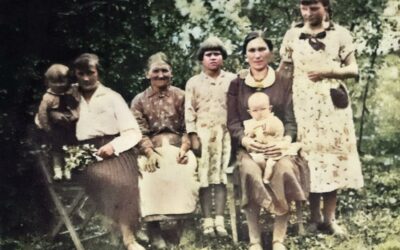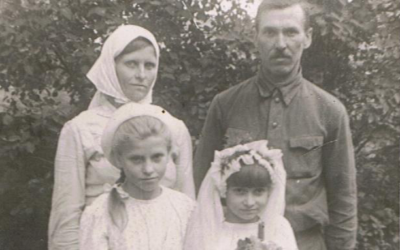What was the life like in an old village?
I often ask questions like this. A good source of knowledge are note from over 100 years before, which were available in former publications. I invite you to imagine this world and to travel back in time in a genealogical journey. In one of the digital libraries I have found a description of the Zamość villages. I think that those characteristics can also be used in a big part to describe villages from the other parts of Poland. An article dated 1902, based on the matarials collected for the agri-business exhibition in Lublin in 1901, written by Roman Świdziński.
The population speaks mostly of a pure Polish language, some only use Ruthenian language. They are medium-sized, their hair is fair and their temperament phlegmatic. Families are big in numbers, and the health of all is splendid. The men shave their beards, and trim the mustache over the lip, shaping them closer to the nose (the older people do it, those who smoke tabacco). Women have nice hair, but they do not care about them, only combing them once a week.

Cottage built of pine logs, consists of one room, hall and so-called chamber, where they put flour, bacon and clothes. The entrance door is located on the longitudinal wall of the house. Hen cottages are not popular at all. Around the hut there is a barn where the grain is stored and treshed. Perpendicular to the barn, right at its corners, they usually put two buildings: one for livestock, i.e. for cows and horses, and second one for pig stools. Attic connects these buildings by closing the quadrangle, or so-called rubber. Agricultural tools like a plow on „tylyżki”, harrows with iron teeth, wooden flails, iron and wood rakes, shovels, scythes, carts on wooden axes, axes, forks and hoes – they hide under the attic and in the barn. Poultry is usually keep in the hallway.
.
The people feed modestly, they eat meat very rarely. Everyday food is: potatoes, cabbage, peas, dumplings on milk and rye wholemeal bread. They cook twice a day: in the morning a borscht or cabbage soup for breakfast, part of which remains in a warm oven for lunch, and potatoes with pork fat, and for dinner, besides borscht and cabbage soup – a millet, barley or buckwheat groin which, put into a warm oven, is also put away until noon; for supper, they cook wheat or buckwheat dumplings with milk. They eat only pork meat and it is during holidays or special celebrations.
For the lighting a smolne (salted?) or tallow muzzles on chimneys, today oil lamps with a glass reserve, commonly used. There is a tree for the fuel, which they receive from court forests, 36 furs per year. They cook on chimneys in iron and clay pots. Underwear after boiling in a lye, they wash in running water, beat them with tadpoles, then hang them on fences, after drying they mangle with mags. Groat grinds on mills, rye, wheat in water mills, usually at once, and only at the ceremony they grind on a plate. Each host with 12 to 18 morgas, maintains 2 to 4 horses, 4 to 6 cattle, mainly cows and heifers, and young piglets sell 3 to 4 rubles per piece. They feed cattle very poorly. In the summer, the cattle are running to the court forest, which is mostly gone, so hungry and without milk they return from their pasture. In the mornings, before driving them out to the forest, they run cows on stakes on the crossroads and roads. In winter, they brew husks with a coir and, sprinkling with bran or flour, give cows, and also floc the dish. Overnight, spring straw, and this is the daily feed for milk cows. So they have very little milk: in winter, on average, one quarter of milk from one cow, they milk them twice a day.
The peasants of the village of Łaziska and the surrounding area run a free farm. For cultivation they use a wooden plow „wędzłużkach” with a share and an iron mouldboard, ie the so-called Moravian and wooden harrow with iron teeth. For several years, instead of a grubber the rougue has been used. Because the hosts, due to the constantly practiced chapters, have little land, they do not leave fallow trees. Usually, barley is sown on the fertilizer, and after the harvest of barley, sow or rye is sown. Potatoes in the field are very little sown, mostly in gardens. In recent years, several clever hosts, seeing a beautiful, newly-established garden in the mansion, have also established a larger garden, bringing the strains from Klemensów.
A few years ago, a dozen apiaries carried out in the original way – in logs, in the last year almost all bees died out of the lack of honey for the winter. There are no fish farms. From the annual customs and ceremonies, we mention the following: After the New Year, they go with a goat and a star; the nativity scene currently does not exist in the villages. At Easter, „Easter eggs” also called „kraszankami” are made.
The Harvest Festival (Dożynki) takes place in the following way: After getting to the grain, wreath a wreath of ears of wheat or rye and put it on the head of the most hard-working girl, and surround her in a circle, bring her to the court, singing the appropriate songs. The girl carrying the wreath puts it on the head of the host and dances around him three times, and older women utter the appeals and wishes for a happy ending of the harvest and for the coming year. For this, the host treats a whole crowd of workers with vodka, and gives the girls carrying wreaths a ruble. After that, the host brings music in the evening, and in the courtyard under the porch dances take place; it should be started by the host himself with the girl carrying the wreath. For a party, dumplings with buckwheat groats are baked, and curd with sour milk mixed together is prepared, in which guests dunk dumplings. Vodka is served, and in many places tea. The party usually lasts until after midnight. „
Thanks to this description, we can move back for over a hundred years. With our own imagination see such a village and people who are working there, peasants working on the farm, and maids spinning and dancing during the harvest festival.
Author:
Ania Bernat-Mścisz
Bardzo proszę o uszanowanie mojej pracy i nie kopiowania treści bez podania źródla,autora wpisu, i linku do bloga.
źródło:
Miesięcznik Wisła rok 1902 tom 3



0 komentarzy